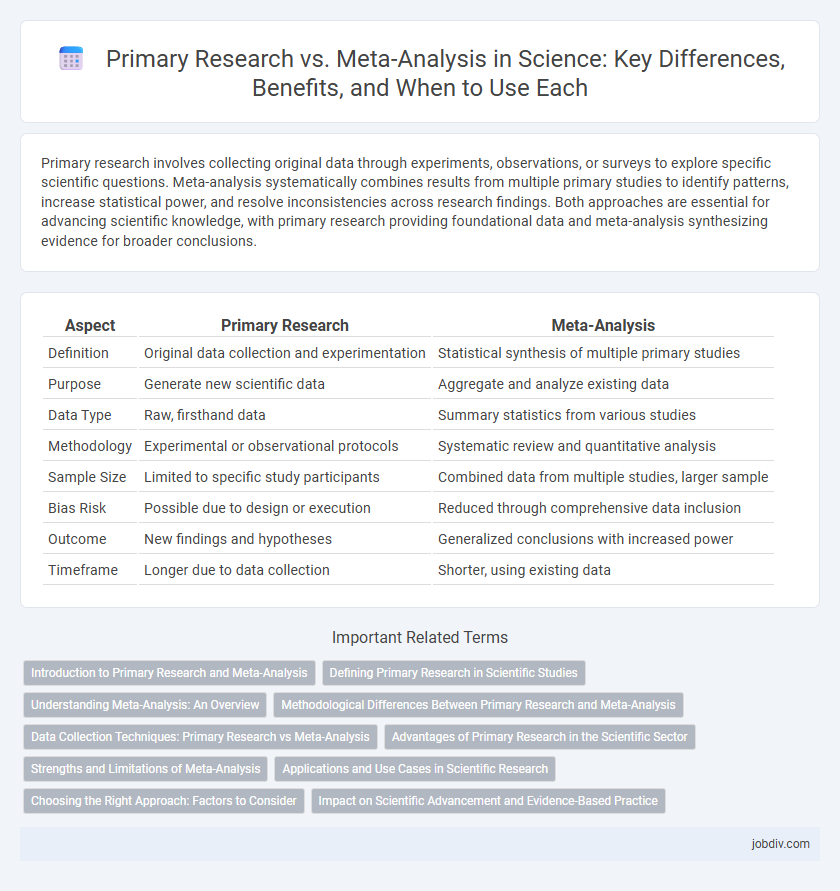Primary research involves collecting original data through experiments, observations, or surveys to explore specific scientific questions. Meta-analysis systematically combines results from multiple primary studies to identify patterns, increase statistical power, and resolve inconsistencies across research findings. Both approaches are essential for advancing scientific knowledge, with primary research providing foundational data and meta-analysis synthesizing evidence for broader conclusions.
Table of Comparison
| Aspect | Primary Research | Meta-Analysis |
|---|---|---|
| Definition | Original data collection and experimentation | Statistical synthesis of multiple primary studies |
| Purpose | Generate new scientific data | Aggregate and analyze existing data |
| Data Type | Raw, firsthand data | Summary statistics from various studies |
| Methodology | Experimental or observational protocols | Systematic review and quantitative analysis |
| Sample Size | Limited to specific study participants | Combined data from multiple studies, larger sample |
| Bias Risk | Possible due to design or execution | Reduced through comprehensive data inclusion |
| Outcome | New findings and hypotheses | Generalized conclusions with increased power |
| Timeframe | Longer due to data collection | Shorter, using existing data |
Introduction to Primary Research and Meta-Analysis
Primary research involves collecting original data through experiments, surveys, or observations to address specific scientific questions, providing firsthand evidence and detailed insights. Meta-analysis aggregates and statistically synthesizes results from multiple primary studies, enhancing the overall sample size and improving the reliability and generalizability of findings. Both methods are essential in scientific research, with primary research generating novel data and meta-analysis integrating diverse results for comprehensive conclusions.
Defining Primary Research in Scientific Studies
Primary research in scientific studies involves the original collection and analysis of data directly from experiments, observations, or surveys. It generates firsthand evidence that forms the foundation for new knowledge and hypothesis testing within a specific field. This method contrasts with meta-analysis, which aggregates and synthesizes findings from multiple primary research studies to draw broader conclusions.
Understanding Meta-Analysis: An Overview
Meta-analysis synthesizes data from multiple primary research studies to provide a comprehensive quantitative assessment of findings, enhancing statistical power and resolving inconsistencies. This method involves rigorous systematic review protocols to identify, evaluate, and combine relevant studies, ensuring replicability and accuracy. Meta-analyses offer critical insights for evidence-based decision-making by integrating vast datasets beyond the scope of individual experiments.
Methodological Differences Between Primary Research and Meta-Analysis
Primary research involves the direct collection and analysis of original data through experiments, surveys, or observations, emphasizing control over variables and study design to ensure validity. Meta-analysis synthesizes aggregated data from multiple primary studies, utilizing statistical techniques to identify overall trends and effect sizes, thereby enhancing generalizability and statistical power. Methodologically, primary research requires rigorous protocol adherence during data collection, whereas meta-analysis demands systematic literature review, strict inclusion criteria, and advanced statistical modeling to integrate heterogeneous datasets.
Data Collection Techniques: Primary Research vs Meta-Analysis
Primary research involves collecting original data directly from experiments, surveys, or observations, ensuring first-hand, specific insights tailored to the study's objectives. Meta-analysis systematically aggregates and statistically analyzes data from multiple existing studies, emphasizing data extraction and synthesis rather than new data collection. Data collection in primary research requires designing instruments and protocols, while meta-analysis depends on rigorous literature search strategies and inclusion criteria to compile relevant datasets.
Advantages of Primary Research in the Scientific Sector
Primary research in the scientific sector offers direct data collection tailored to specific hypotheses, ensuring high relevance and accuracy for novel investigations. It provides control over methodological variables, enhancing the reliability and validity of experimental outcomes. This approach allows researchers to generate original findings that contribute uniquely to scientific knowledge and innovation.
Strengths and Limitations of Meta-Analysis
Meta-analysis synthesizes data from multiple primary research studies, increasing statistical power and improving the generalizability of findings by aggregating diverse samples and methodologies. However, its accuracy depends heavily on the quality and heterogeneity of included studies, which can introduce bias and limit the validity of conclusions if poorly controlled. Meta-analysis may also overlook nuanced or contextual factors present in individual studies, potentially masking variations important for specific research questions.
Applications and Use Cases in Scientific Research
Primary research provides original data through experiments or observations, essential for generating novel scientific insights and testing hypotheses in various fields such as medicine, biology, and social sciences. Meta-analysis synthesizes results from multiple primary research studies to identify patterns or effect sizes, enhancing evidence reliability and guiding clinical guidelines, policy-making, and systematic reviews. While primary research fuels innovation, meta-analysis supports evidence-based decision-making by consolidating knowledge across studies.
Choosing the Right Approach: Factors to Consider
Selecting between primary research and meta-analysis depends on research objectives, available data, and resource constraints. Primary research provides original data essential for novel hypotheses or unexplored areas, while meta-analysis synthesizes existing studies to identify patterns or validate findings with increased statistical power. Factors such as sample size, data quality, research timeline, and the need for comprehensive evidence synthesis guide the optimal approach in scientific investigations.
Impact on Scientific Advancement and Evidence-Based Practice
Primary research generates original data through experiments or observations, directly contributing to scientific advancement by uncovering novel findings and hypotheses. Meta-analysis synthesizes results from multiple primary studies, enhancing evidence-based practice by providing robust, aggregated conclusions with increased statistical power. The integration of both methods accelerates knowledge development and informs clinical guidelines with higher reliability.
Primary Research vs Meta-Analysis Infographic

 jobdiv.com
jobdiv.com